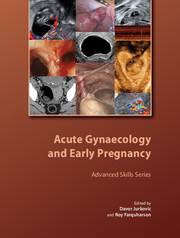Book contents
- Frontmatter
- Contents
- About the authors
- Acknowledgements
- Abbreviations
- Preface
- 1 Organisation and delivery of emergency care in early pregnancy and acute gynaecology
- 2 Epidemiology and aetiology of miscarriage and ectopic pregnancy
- 3 Diagnosis of miscarriage
- 4 Conservative and surgical management of miscarriage
- 5 Management of hyperemesis gravidarum
- 6 Diagnosis and treatment of recurrent miscarriage
- 7 Differential diagnosis and management of molar pregnancy
- 8 Drugs in early pregnancy
- 9 Diagnosis of tubal ectopic pregnancy
- 10 Conservative management of tubal ectopic pregnancy
- 11 Surgical management of tubal ectopic pregnancy
- 12 Diagnosis and management of non-tubal ectopic pregnancy
- 13 Diagnosis and management of acute pelvic pain
- 14 Management of vaginal bleeding in the acute clinical setting
- 15 Current concepts in screening and outpatient management of pelvic inflammatory disease
- 16 Diagnosis and management of haemorrhagic and septic shock
- 17 Role of minimally invasive surgery in acute gynaecology
- Index
1 - Organisation and delivery of emergency care in early pregnancy and acute gynaecology
Published online by Cambridge University Press: 05 July 2014
- Frontmatter
- Contents
- About the authors
- Acknowledgements
- Abbreviations
- Preface
- 1 Organisation and delivery of emergency care in early pregnancy and acute gynaecology
- 2 Epidemiology and aetiology of miscarriage and ectopic pregnancy
- 3 Diagnosis of miscarriage
- 4 Conservative and surgical management of miscarriage
- 5 Management of hyperemesis gravidarum
- 6 Diagnosis and treatment of recurrent miscarriage
- 7 Differential diagnosis and management of molar pregnancy
- 8 Drugs in early pregnancy
- 9 Diagnosis of tubal ectopic pregnancy
- 10 Conservative management of tubal ectopic pregnancy
- 11 Surgical management of tubal ectopic pregnancy
- 12 Diagnosis and management of non-tubal ectopic pregnancy
- 13 Diagnosis and management of acute pelvic pain
- 14 Management of vaginal bleeding in the acute clinical setting
- 15 Current concepts in screening and outpatient management of pelvic inflammatory disease
- 16 Diagnosis and management of haemorrhagic and septic shock
- 17 Role of minimally invasive surgery in acute gynaecology
- Index
Summary
Introduction
Early pregnancy problems account for a major part of all gynaecological emergencies. Other less common gynaecological emergencies are acute pain, severe vaginal bleeding and collapse, which are covered in detail in other chapters.
All women with early pregnancy and acute gynaecological problems should receive prompt referral to a dedicated early pregnancy unit that provides efficient, evidence-based care with access to appropriate information and counselling. The National Service Framework recommends that all women should have access to an early pregnancy unit, which should be easily available (www.earlypregnancy.org.uk). Ideally, these services should also be directly accessible to GPs.
A report of the National Confidential Enquiry into Patient Outcome and Death in 2007 stated that when a patient with an acute healthcare problem arrives in hospital, he or she requires prompt clinical assessment, appropriate investigations and institution of a clear management plan. There should be an early decision regarding the need to involve all relevant specialties and other required services followed by a timely review by an appropriately trained senior clinician. This should be undertaken in an environment that is best suited to meet the patient's clinical needs. Although there is conflicting opinion on the optimal location for the assessment of emergency admissions, it has been recommended that women presenting with early pregnancy complications should undergo initial assessment in dedicated emergency assessment units. The rationale for the use of emergency assessment units is that they can reduce both the emergency department's workload and hospital length of stay.
- Type
- Chapter
- Information
- Acute Gynaecology and Early Pregnancy , pp. 1 - 10Publisher: Cambridge University PressPrint publication year: 2011
- 1
- Cited by



